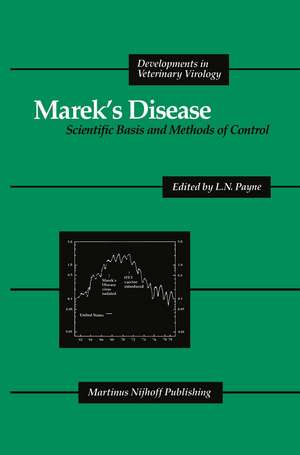Marek’s Disease: Scientific Basis and Methods of Control: Developments in Veterinary Virology, cartea 1
Editat de L.N. Payneen Limba Engleză Paperback – 5 oct 2011
Preț: 582.46 lei
Preț vechi: 685.24 lei
-15% Nou
Puncte Express: 874
Preț estimativ în valută:
111.45€ • 116.37$ • 92.24£
111.45€ • 116.37$ • 92.24£
Carte tipărită la comandă
Livrare economică 04-18 aprilie
Preluare comenzi: 021 569.72.76
Specificații
ISBN-13: 9781461296355
ISBN-10: 1461296358
Pagini: 380
Ilustrații: XVI, 360 p.
Dimensiuni: 155 x 235 x 20 mm
Greutate: 0.53 kg
Ediția:Softcover reprint of the original 1st ed. 1985
Editura: Springer Us
Colecția Springer
Seria Developments in Veterinary Virology
Locul publicării:New York, NY, United States
ISBN-10: 1461296358
Pagini: 380
Ilustrații: XVI, 360 p.
Dimensiuni: 155 x 235 x 20 mm
Greutate: 0.53 kg
Ediția:Softcover reprint of the original 1st ed. 1985
Editura: Springer Us
Colecția Springer
Seria Developments in Veterinary Virology
Locul publicării:New York, NY, United States
Public țintă
ResearchCuprins
1. Historical review.- 1. Introduction.- 2. József Marek and the first description of Marek’s disease.- 3. Classical studies, 1920–1939.- 4. The middle period, 1940–1959.- 5. Events since 1960.- 2. Clinical disease and its economic impact.- 1. Introduction.- 2. Occurrence of infection and disease.- 3. The disease during production.- 4. The disease at slaughter.- 5. Economic loss from disease.- 6. Conclusions.- 3. Pathology.- 1. Introduction.- 2. Gross appearances.- 3. Histopathological and ultrastructural appearances.- 4. Lymphoma-derived cell lines.- 5. Transplantable lymphomas.- 6. Factors affecting pathogenesis.- 4. Characteristics of the virus.- 1. Introduction.- 2. Virus strains.- 3. Physical and chemical properties.- 4. Isolation and cultivation.- 5. Virus replication.- 6. Viral antigens.- 7. Concluding remarks.- 5. Molecular biology of the virus.- 1. Introduction.- 2. Viral deoxyribonucleic acid.- 3. Viral proteins.- 4. Replication.- 5. Oncogenesis.- 6. Concluding remarks.- 6. Laboratory diagnosis.- 1. Introduction.- 2. Diagnosis of a field outbreak.- 3. Diagnosis of infection.- 7. Immunity.- 1. Introduction.- 2. Expression of impunity.- 3. Immune responses to Marek’s disease-associated antigens.- 4. Contribution of immune responses to the expression of immunity.- 5. Immunosuppression.- 8. Principles of vaccination.- 1. Introduction.- 2. Types of vaccine.- 3. Responses to vaccination.- 4. Mechanisms of protection.- 5. Factors affecting vaccine efficacy.- 6. Investigation of vaccine failures.- 7. Comparative efficacy of vaccines.- 8. Strategies and perspectives.- 9. Production of vaccines.- 1. Introduction.- 2. Production methods.- 3. Conclusion.- 10. Quality control and standardization of vaccines.- 1. Introduction.- 2. Safety.- 3. Efficacy.- 4. Purity.-5. Standard preparations.- 6. Recommended tests.- 11. Genetic resistance.- 1. Significance and historical aspects of genetic resistance.- 2. Expression of resistance.- 3. Mechanism of genetic resistance.- 12. Spread of Marek’s disease.- 1. Introduction.- 2. Spread of infection.- 3. Flock infection.- 4. Factors affecting the incidence of Marek’s disease.- 13. Control of Marek’s disease by the poultry industry: practical considerations.- 1. Introduction.- 2. Control by hygiene.- 3. Breeding for resistance.- 4. Control by vaccination.












